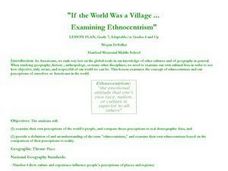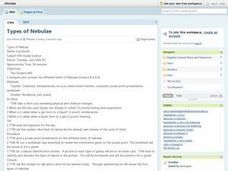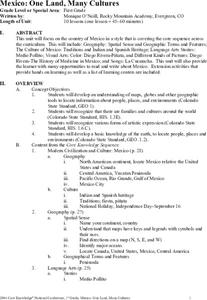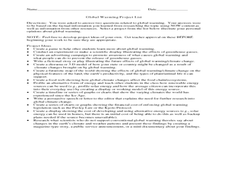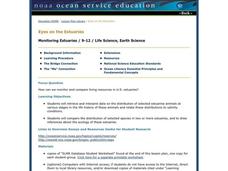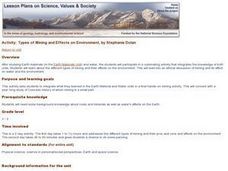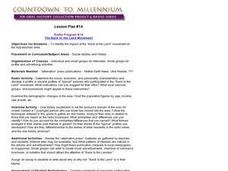Curated OER
China's Ethnic Minorities
Third graders are introduced to various Chinese ethnic groups. They consider how geography affects ethnic groups and examine artifacts produced by Chinese peoples. They prepare a presentation of their research and artifact interpretation.
Curated OER
Fossilworks
Young scholars research fossils and fossil formation. They explain how fossils are formed, identify fossil formations and use casting plaster to produce fossil replicas.
Curated OER
China: One Nation: Two Futures
Tenth graders explore the evolution of Chinese communism to its present export-driven economy. Working in groups, they examine various articles about reforms in Chinese society. They write essays about the impact of political reform on...
Curated OER
Stand Up Bunny
Pupils create "stand-up bunnies" for classroom display in this early-elementary Art lesson ideal for the spring months. A bunny template and design ideas are included to aid in the teaching process of this fun and quick lesson.
Curated OER
Tie Dye Eggs
Students create "tie-dye" easter eggs in this easy elementary school lesson. Materials needed include paper towels, food coloring, eggs, and rubber gloves. This Easter lesson can be accomplished in 30 minutes with extra time needed for...
Curated OER
Van Gogh's Sunflowers
Students create replicas of Vincent Van Gogh's Sunflowers using construction paper, tissue paper, glue, and scissors in this art lesson for the elementary classroom. The flowers can then be displayed in the room as a class bulletin board.
Curated OER
Ptolemy vs. Copernicus
Students list differences in the diagrams of a geocentric universe and a heliocentric universe. They students describe the religious impact of this change on man's conception of the universe and man's place within it. Students describe...
Curated OER
The Ultimate Predator
Learners listen to a lecture by the teacher about the "Ultimate Predator." They design a new "Ultimate Predator." Students present their creations to the class and attempt to convince their classmates that their predator is indeed the...
Curated OER
If the World Was a Village...Examining Ethnocentrism
Seventh graders examine their own perceptions of world's people, compare those perceptions to real demographic data, provide definition and understanding of term "ethnocentrism," and examine their own ethnocentrism based on comparison of...
Curated OER
Athabaskan Migration & Bering Strait
Learners examine the various migration patterns of the Athabaskan. In groups, they discuss the Bering Strait Land Bridge theory of migration and take notes on a lecture from their teacher. To end the lesson, they brainstorm the...
Curated OER
Athabaskan Migration & Bering Strait
Students study Athabaskan migration patterns and the Bering Strait Land Bridge theory. They investigate the importance of the expansion of trade and compare the differences between American Indian oral tradition accounts of origin and...
Curated OER
Types Of Nebulae
Eighth graders explore the different types of nebulae that can be found in the solar system. They view a PowerPoint presentation about the material and identify each nebulae as it is presented. Students also discuss the life cycle of a...
Curated OER
Mexico: One Land, Many Cultures
Students research and study the country of Mexico and complete a project about it. In this Mexico lesson plan, students research Mexico's geography, traditions, art, songs, stories, and legends that are native to Mexico.
Curated OER
WWJD: What Would Jimmy Do?
Students interpret historical evidence presented in primary and secondary resources. In this 1973 oil crisis lesson, students research details regarding President Carter's policies regarding the oil crisis that produced a scarcity...
Curated OER
Lesson Plan: Global Warming
Students explore the concept of global warming. In this climate change lesson plan, students explore the provided links to PBS NOW sources and research the greenhouse effect and the effects of global warming. Students support their...
Curated OER
Eyes on the Estuaries
Students study estuaries and compare several ones in the U.S. In this estuary lesson students interpret data and compare the distribution of different species.
Curated OER
Social Studies: Your Family Does What?
Sixth graders compare and contrast their own personal culture with that of Japan. They fill out questionnaires, compile the results, and match them with Japanese answers to the same forms. Students create a Venn diagram of the...
Curated OER
Changes Close To Home
Students interview the senior citizens in their community. While interviewing them, they identify perceptions they have about the local climate. Using the internet, the compare the results of the interview to those of public thirty...
Curated OER
Natural Hazards
High schoolers evaluate the hazards of naturally occurring events. After watching a video concerning safety hazards, students work in groups to discuss the safety issues involved in taking a trip to a mountainous region. ...
Curated OER
How We Get From Here to There
Students recognize various types of movement people rely on to get from one place to another, locate the forms of movement on a map and choose one form of movement and research its path.
Curated OER
Radio Program #14-The Back to the Land Movement
Students identify the impact of the "Back to the Land" movement on the Appalachian area. They interview people who have moved back or know someone who has moved back to the Appalachian area. Students graph out profiles of "typical"...
Curated OER
Stargazing Astronomy: A Ceiling Full of Stars
Students make an observe a planetarium using a can with nail holes, black paper and a flashlight.
Curated OER
Tracking the Movement of Sunspots
Students examine how the development of new technology has increased our knowledge of how the sun works. Students study sunspots through the use of solar imaging from satellite instruments.
Curated OER
Life's Big Questions: Where Did Life Come From?
Students explore the life forms that live in the hot springs of Yellowstone. They examine how microscopic creatures can survive in these extreme conditions. Students perform experiments to observe growth samples and demonstrate how a...








